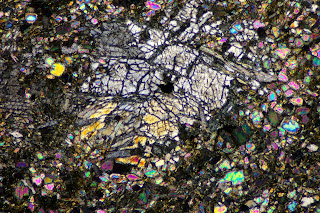 |
| Click on image to enlarge. Photo © Daniel R. Snder |
Tremolite (center) in Yellow Dog peridotite. Tremolite and actinolite, both calcic clinoamphiboles, are very similiar in appearance, having bladed or fibrous crystals or, as in this image, thin columnar crystals in parallel aggregates. Tremolite is the magnesian end-member of the tremolite-ferro-actinolite solid solution, while iron substitutes for some of the magnesium in actinolite.
Two diagnostic differences are that actinolite is slightly pleochroic and ranges from pale green to deep green in thin section (the greater the iron content, the deeper the green). Conversely, tremolite is colorless in thin section and non-pleochroic. In PPL, this specimen proved to be colorless and non-pleochroic - thus it is tremolite.
Tremolite alters to talc and to chlorite. In the above image, talc borders tremolite on the top and right edges of the bladed portion (granular mineral with very high birefringence), and also forms small clots below it and to the left. Rounded mineral grains around periphery of image are olivine. Pyroxene (gray) is at right, and mica (red) is at left. XPL. Imaged area 2.7 mm x 4 mm.
Higher magnification image (below) of bladed portion of tremolite bundle and talc border. Gray grain at lower right is serpentine. XPL. Imaged area 1.3 mm x 2 mm.
 |
Click on image to enlarge. Photo © Daniel R. Snyder
|
Clinopyroxene altering to tremolite:
 |
| Click on image to enlarge. Photo © Daniel R. Snyder |
A large anhedral grain of clinopyroxene (magenta and violet) is undergoing alteration to tremolite (light-colored mineral at left, bottom center, and right). Unlike the tremolite in the example above, the habit in this image is fibrous (asbestiform). The fibers are clearly visible against the background of the dark band of chlorite at the upper right. XPL. Imaged area 1.3 mm x 2 mm.
Marquette County, northern Michigan.
For more information on the Yellow Dog peridotite, see posts from January 28, 2011, and May 27, 2011. For still more information, scroll to the top of this page and enter "Yellow Dog peridotite" in the search box at the upper right. You can also click on "Yellow Dog peridotite" in the cloud at the bottom of the page. Be sure to look at the last post on a page, and click on "newer posts" or "older posts", since Blogspot doesn't always display everything at once.


















































